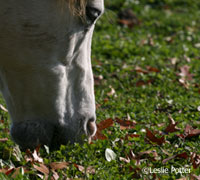 With the intense heat and dry weather hitting parts of the country this summer, University of Kentucky College of Agriculture experts are recommending horse owners take stock of their pastures and consider other management options such as supplementing with hay.
With the intense heat and dry weather hitting parts of the country this summer, University of Kentucky College of Agriculture experts are recommending horse owners take stock of their pastures and consider other management options such as supplementing with hay.
“A brief pasture walk can reveal whether a pasture has edible grass or just green weeds. If it is not clear whether there is adequate grass for horses in the paddock, the best test is to offer hay and see whether horses consume it,” she said.
“A practical approach is to put out a few flakes of hay and then observe the horses. If they devour the hay in a short time, then pasture quality is probably poor and hay is needed,” Lawrence said. “If the hay is untouched or is mostly wasted, then it may not be needed. But, just because it is not needed now doesn’t mean it won’t be needed in a few days or a week.”
The amount and type of hay that should be fed will depend upon the type of horse and the condition of the horse and pasture. For mature idle horses in good body condition, a mid-maturity grass or grass-legume mix hay will provide an adequate substitute for pasture during the summer months. However, more nutritious hay should be fed to lactating mares, foals and weanlings. Legume hays or early maturity grass-legume mixes are suitable for horses with higher requirements. Horses with a low body condition (too thin) should also be fed hay with a higher nutritive value.
According to Lawrence, a mature idle horse will generally eat about 20 pounds of pasture or hay forage per 1,000 pounds of body weight per day. Lactating mares will eat about 5 to 10 pounds more; and an allowance should also be made for their nursing foals. Because pasture may provide some of the needed forage, the amount of hay fed each day may vary. A common recommendation is to adjust the hay offered to an amount that horses will clean up between feedings.
Horses with high nutrient requirements also will usually require some concentrate supplementation, such as sweet feed or pellets, in addition to hay and pasture; concentrate, however, should not be substituted for all hay or pasture as this could result in gastrointestinal problems.
Providing hay is not just important for the horse’s nutritional state, Lawrence said. If hay is available in the pasture, it provides a substitute forage source for horses and may reduce overgrazing. Overgrazing, particularly when plants are already stressed by heat and low moisture, can negatively affect long-term pasture productivity.
Even though cool-season grasses may not be growing in the pasture during this hot, dry period, less desirable plants may continue to thrive. When pasture conditions are poor, hungry horses may be more likely to eat weeds or toxic plants. Also, plants that may not normally cause a problem may become toxic to horses during stressful growing conditions, or when a period of rain follows a period of drought.
For example, young shoots of Johnson grass that emerge when a rain follows a long drought period may be toxic to horses. Hungry horses may chew on thorny weeds or bushes and sustain mouth injuries. When horses can satisfy their hunger with hay or with desirable pasture plants during good growing conditions, they will be less likely to consume toxic or injurious plants, Lawrence said.
Along with adequate forage, horses should have access to plenty of clean water. Normal pasture plants are high in moisture, but during hot, dry conditions, their water content is greatly decreased. Similarly, hay has very little moisture, so horses usually drink more water when they are receiving dry forage than when they are consuming succulent pasture.
Horses also maintain body temperature by evaporative cooling from sweat. Sweat is mostly water but also contains several electrolytes, particularly sodium, chloride and potassium. Most forages provide potassium but not much sodium or chloride, so in addition to providing plenty of water, horses should have access to a salt lick.






thats a solution if have plenty endless supply of hay not everyone is that fortunate have already been told to ration what little have because most likely won’t have second cutting
This article doesn’t seem to address pasture management at all. I know how to feed my horses when pasture is low due to drought. I though I would get some advice on how to maintain my pasture during the drought months of summer.
I rotate the two pastures I do have, letting the horse graze early and late in the day. I have some big round bales from last winter, which I am supplementing.